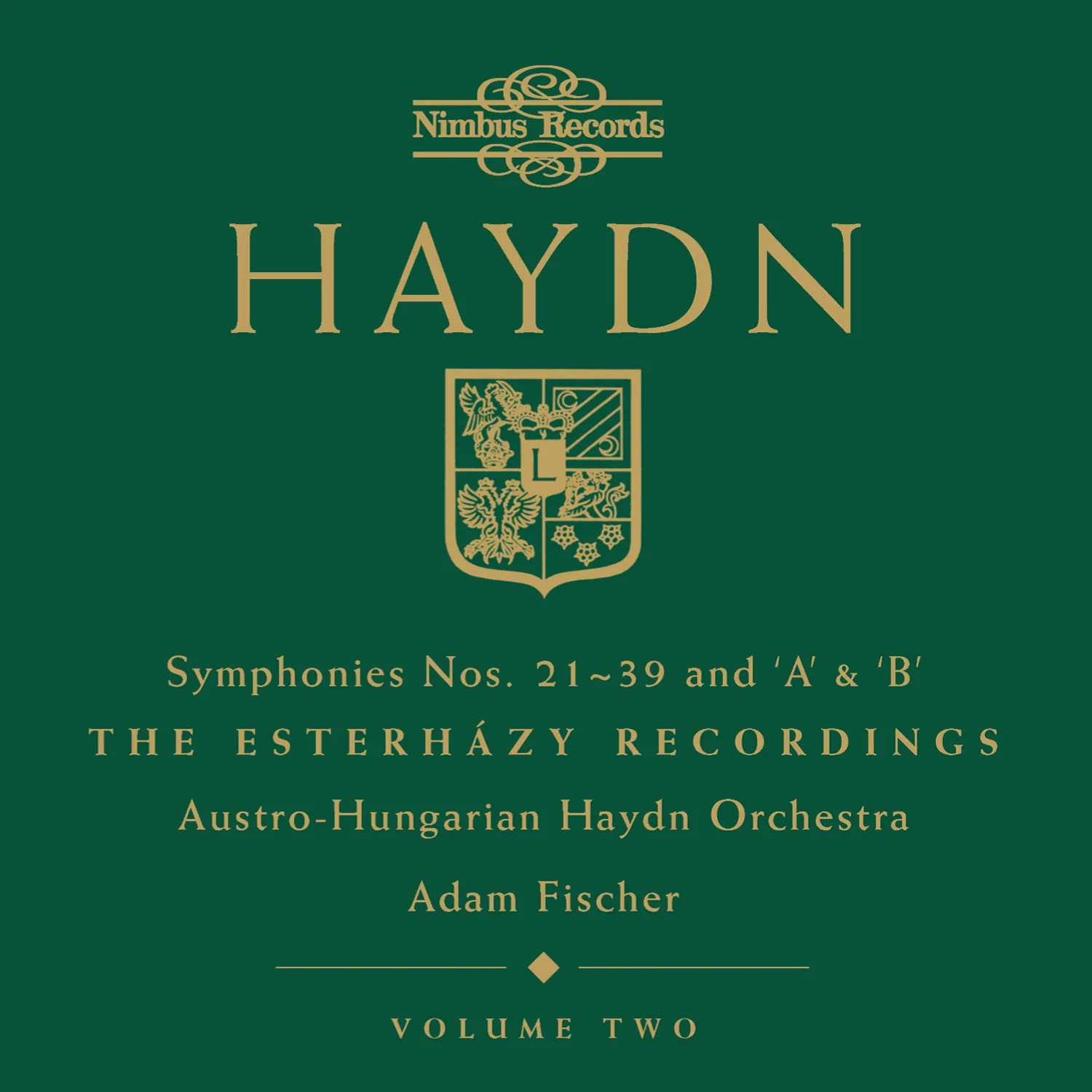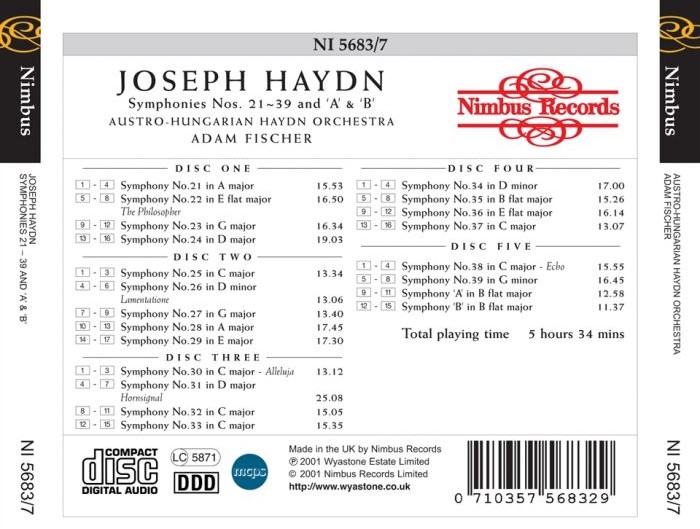I am continuing apace with Haydn's symphonies from the series put out by Ádám Fischer and the Austro-Hungarian Haydn Orchestra.
In Volume 1 (BLOG), I mentioned how each of the composer's symphonies kept me alert without feeling the drudgery of sameness across twenty works. After all, Haydn's symphonies were not meant to be listened to like I am. This is akin to binging M*A*S*H over a week or two.
With Symphony no. 40, which is not included in this set, I pretty much say goodbye to Haydn's output under Count Morzin, and his pre-1767 entries with the Princes Esterházy. Not completely, as following these symphonies numerically does not equate to chronologically, but I am looking forward to moving into the composer's middle-period symphonies.
As with my blog entry on Volume 1, I will do some Haydn symphonies By The Numbers:
Employ
Count Morzin: Six (25, 27, 32, 37, A & B)
Princes Esterházy: Fifteen
Obviously, as Haydn's symphony numbers go up, the less we will hear from Count Morzin. There are two or three symphonies which are up in the air regarding which Esterházy they were composed for as well.
I have seen differing attributions for Symphony no. B; both as an early Morzin symphony and as an early Esterházy symphony. For my purposes, I put it with Symphony no. A.
Nicknames
Philosopher (22)
Lamentation (26)
Alleluia (30)
Hornsignal (31)
Echo (38)
The Fist (39)
Nicknames aren't important in the scheme of things; after all, Haydn usually didn't nickname them himself. But listeners often gravitate towards these subtitled symphonies.
Nicknames often represent an orchestration choice, a specific musical attribute, or a mood / visualized impression heard within the music. Coincidence or not, many of the oddities and quirks listed below fall within these nicknamed symphonies.
Movements
Three: 5 (three for Count Morzin)
Four: 19 (three for Count Morzin)
Eventually the three-movement format will give way to four movements, but for now I will track the occasionality of the tripartite form.
Three of the symphonies place the Minuet movement, normally positioned in the third slot, as a second movement (32, 37, B). Two symphonies do away with the Minuet dance altogether (27 & A), while another two symphonies conclude on the Minuet (26 & 30). No. 30 also contains a double Trio, an first among these early symphonies.
Opening Tempo
Fast: Seventeen
Slow: Three (21, 22, 34)
Slow Intro: One (25)
The three symphonies which begin Adagio are of the Sonata da Chiesa format. Like the number of movements above, this is an older form which won't last long. Symphony no. 25 also begins Adagio, however, it is merely an introduction to the Allegro proper. As I continue Haydn's symphonies, I expect to hear more of the composer's love of slow-opening introductions.
Instruments
Flute: 24, 30
English Horn: 22
Bassoon: B
Four Horns: 31, 39
Trumpet & Timpani: 30, 32, 33, 37, 38
The standard setup for a Haydn symphony is strings, two oboes, two horns, and bassoon doubling the bass line or as part of a continuo. I mention bassoon in my list above because the Trio of Symphony no. B contains a bassoon solo, thus the instrument is thrust into the spotlight instead of relegated as an ensemble player.
Flute only appears twice, but in quite different ways. In Symphony no. 24, the flute is the primary interest, whereas in Symphony no. 30, flute is integrated into the orchestral conversation. Oddly, Haydn replaces oboes with English Horns in Symphony no. 22, creating a unique double-reed sound.
I must admit I grew weary of C-Major symphonies across the 30s. The presence of trumpet and timpani is not a favorite of mine here, and having Nos. 30-33 all in one go was just too much for me. For Haydn, it must have been a very festive time to need so many of this type of symphony.
Time Signatures & Tempo Markings
3/4: Ten
4/4: Eight
2/4: Three
I had originally thought first-movement time signatures in 3/4 were rare in Haydn, however amongst this lot, they are almost as frequent as common time. Since a few symphonies begin at a slow tempo, 3/4 ends up being prevalent to begin these works.
Fifteen of these symphonies open at a typical Allegro tempo, or at least some form such as Allegro molto. Curiously, three symphonies begin at a Presto (37) or Vivace (33 & 36) tempo, an atypical choice from Haydn I think.
The 2/4 Andante remains Haydn's favorite second slow-movement tempo. There are a couple 6/8 Siciliano settings (27 & 31), plus the composer starts using the 3/8 time signature (38 & 39) for the second movement as well.
Final movements tend to be set at Presto, but there is a half-and-half mix of simple and compound meters. I believe Symphony no. 31 is the only theme and variations movement thus far, put in the finale position in No. 31.
Title Key Signatures
Sharp: Eight
Flat: Seven
C Major: Six
Minor Key: Three
I have already commented on the prevalence of C-Major symphonies, although I notice Haydn wanting to explore F Major while in that key. More interesting is the increase in flat-keyed symphonies amongst a trio of minor-keyed symphonies. Symphony no. 34 is an outlier; this work's first movement is in D minor, but the composer never returns, preferring D Major for the rest of the work. Symphonies no. 26 & 39 are solid minor-keyed compositions, fully exploring and coming back to those minor tonal centers.
I count six symphonies as homotonal in this volume; that is, where each movement is centered on the same pitch. Thirteen of the symphonies change key or mode moving from the Minuet to the Trio, an aspect I hadn't really recorded previously.
Length
Again, Fischer is inconsistent with following or not following repeats, thus timing is probably not necessary. However, it should be noted that no symphony in this set times shorter than 13 minutes and none play over 20 minutes. I believe Haydn to be very efficient in his music making in these works, but also not completely set on sonata-allegro form, rondo, and the like. With further development, I expect lengthier runtimes.
As to be expected, I like how the orchestra is captured sonically in the later sessions compared to the earlier ones. The 'Echo' symphony was particularly effective.
On the other hand, I notice more period-practice techniques in the later recordings, and tempos seem more urgent. This isn't a problem, more than it is simply awareness.
More concerning with the later recordings is Ádám Fischer's willfulness and quirks of interpretation. I like all of the choices for using solo strings, whether decided upon among the ensemble or from the score. For example, the many pregnant pauses in Symphony no. 39 -Haydn is great at keeping the listener guessing, but my qualms come when Fischer takes the music out of metrical time to give extra winks to Haydn's many rests. In my opinion, these moments don't need extra attention, and the decision ends up focusing more on the leader than the composer. There are a few of these moments across the set, but nothing as egregious as Fischer leading the Danish Chamber Orchestra on Naxos as of late.
Apart from that, I enjoy these performances, the Esterházy Palace sound, and Haydn's symphonies. A few times I compared tempos to Antal Doráti's famous set of Haydn symphonies, just to see if my mind was going crazy listening to Fischer's tempos, but I find both approaches work just fine. Since I did those very few comparisons, I am reminded how much I enjoy the fuller orchestral sound from Dorati, although the lithe sound under Fischer is merely different, not worse.
I have already continued on to Symphonies 40 - 42, and I am enjoying the continuing experiments from Haydn the composer. For those interested, you can find my thoughts on any of the individual CDs or symphonies in the Composers section under Haydn.



No comments:
Post a Comment